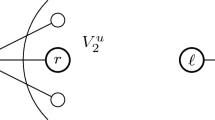Abstract
The tree \(t^*\)-spanner problem is an NP-hard problem, which is concerned with finding a spanning tree in a given undirected weighted graph, such that for each pair of nodes the ratio of the shortest distance in the spanning tree and the shortest distance in the given graph is bounded by t. The goal is to find a spanning tree, which gives the minimal t. This problem is associated with many network design applications, but in particular, in the context of architecture of distributed systems. We introduce mixed-integer programming formulations for the tree \(t^*\)-spanner problem, and present a branch-and-cut solution approach based on these formulations. The branch-and-cut is enhanced with an initialization procedure and a primal heuristic. A computational study is done to assess the effectiveness of our proposed algorithmic strategies. To the best of our knowledge, this is the first time that an exact approach is proposed for this problem.

Similar content being viewed by others
References
Althöfer, I., Das, G., Dobkin, D., Joseph, D., Soares, J.: On sparse spanners of weighted graphs. Discrete Comput. Geom. 9(1), 81–100 (1993)
Álvarez-Miranda, E., Fernández, E., Ljubić, I.: The recoverable robust facility location problem. Transp. Res. Part B: Methodol. 79, 93–120 (2015)
Awerbuch, B.: Complexity of network synchronization. J. Assoc. Comput. Mach. 32(4), 804–823 (1985)
Awerbuch, B., Baratz, A., Peleg, D.: Effcient broadcast and light-weight spanners. Weizmann Institute of Science, Technical Report N. CS92-22 (1992)
Bandelt, H., Dress, A.: Reconstructing the shape of a tree from observed dissimilarity data. Adv. Appl. Math. 7(3), 309–343 (1986)
Bharath-Kumar, K., Jaffe, J.: Routing to multiple destinations in computer networks. IEEE Trans. Commun. 31(3), 343–351 (1983)
Bhatt, S., Chung, F., Leighton, T., Rosenberg, A.: Optimal simulations of tree machines. In: Proceedings of the 27th Annual Symposium on Foundations of Computer Science, pp. 274–282 (1986)
Cai, L., Corneil, D.: Tree spanners. SIAM J. Discrete Math. 8(3), 359–387 (1995)
Cai, L., Mark Keil, J.: Computing visibility information in an inaccurate simple polygon. Int. J. Comput. Geom. Appl. 7(6), 515–537 (1997)
Cherkassky, B., Goldberg, A.: On implementing push-relabel method for the maximum flow problem. In: Balas, E., Clausen, J. (eds.) Proceedings of IPCO IV, vol. 920 of LNCS, pp. 157–171. Springer, Berlin (1995)
Costa, A.: A survey on benders decomposition applied to fixed-charge network design problems. Comput. Oper. Res. 32(6), 1429–1450 (2005)
Elkin, M., Emek, Y., Spielman, D., Teng, S.: Lower-stretch spanning trees. SIAM J. Comput. 38(2), 608–628 (2008)
Emek, Y., Peleg, D.: Approximating minimum max-stretch spanning trees on unweighted graphs. SIAM J. Comput. 38(5), 1761–1781 (2009)
Fischetti, M., Leitner, M., Ljubić, I., Luipersbeck, M., Monaci, M., Resch, M., Salvagnin, D., Sinnl, M.: Thinning out Steiner trees: a node-based model for uniform edge costs. Math. Program. Comput. 9(2), 203–229 (2017a)
Fischetti, M., Ljubić, I., Sinnl, M.: Redesigning benders decomposition for large-scale facility location. Manag. Sci. 63(7), 2146–2162 (2017b)
Koch, T., Martin, A.: Solving Steiner tree problems in graphs to optimality. Networks 32(3), 207–232 (1998)
Liestman, A., Shermer, T.: Additive graph spanners. Networks 23(4), 343–363 (1993)
Magnanti, T., Wolsey, L.A.: Optimal trees. Handb. Oper. Res. Manag. Sci. 7, 503–615 (1995)
Magnanti, T., Mireault, P., Wong, R.: Tailoring benders decomposition for uncapacitated network design. In: Gallo, G., Sandi, C. (eds.) Netflow at Pisa. Mathematical Programming Studies, vol. 26, pp. 112–154. Springer, Berlin (1986)
Marble, J., Bekris, K.: Asymptotically near-optimal is good enough for motion planning, pp. 419–436 (2017)
Peleg, D., Ullman, J.: An optimal synchronizer for the hypercube. SIAM J. Comput. 18(4), 740–747 (1989)
Peleg, D., Upfal, E.: A tradeoff between space and efficiency for routing tables. In: Proceedings of the Twentieth Annual ACM Symposium on Theory of Computing, pp. 43–52. ACM (1988)
Prim, R.C.: Shortest connection networks and some generalizations. Bell Labs Tech. J. 36(6), 1389–1401 (1957)
Singh, K., Sundar, S.: Artifical bee colony algorithm using problem-specific neighborhood strategies for the tree t-spanner problem. Appl. Soft Comput. 62, 110–118 (2018)
Venkatesan, G., Rotics, U., Madanlal, M., Makowsky, J., Pandu Rangan, C.: Restrictions of minimum spanner problems. Inf. Comput. 136(2), 143–164 (1997)
Wong, R.: A dual ascent approach for Steiner tree problems on a directed graph. Math. Program. 28(3), 271–287 (1984)
Acknowledgements
E.A.-M. acknowledges the support of the Chilean Council of Scientific and Technological Research, CONICYT, through the grant FONDECYT N. 1180670 and through the Complex Engineering Systems Institute (ICM-FIC:P-05-004-F, CONICYT:FB0816).
Author information
Authors and Affiliations
Corresponding author
Rights and permissions
About this article
Cite this article
Álvarez-Miranda, E., Sinnl, M. Mixed-integer programming approaches for the tree \(t^*\)-spanner problem. Optim Lett 13, 1693–1709 (2019). https://doi.org/10.1007/s11590-018-1340-0
Received:
Accepted:
Published:
Issue Date:
DOI: https://doi.org/10.1007/s11590-018-1340-0




